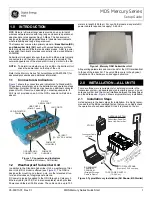
39
Reference Manual
00809-0100-4853, Rev AB
Operation and Maintenance
January 2017
Operation and Maintenance
4.3.3
Determining necessary sensor trims
Bench calibration is not recommended for new instruments. The transmitter can be set back to factory
settings using the
Restore Factory Calibration
. For transmitters that are field installed, the manifolds
discussed in
“Manifold operation” on page 32
allow the differential transmitter to be zeroed using the
zero trim function. Both 3-valve and 5-valve manifolds are discussed. This field calibration will eliminate
any pressure offsets caused by mounting effects and static pressure effects of the process. Determine
the necessary trims with the following steps.
1. Complete a zero trim.
2. Apply pressure.
3. Check the pressure, if the pressure does not match the applied pressure, perform a sensor trim (see
).
4.3.4
Types of pressure trim
Zero trim
Zero trim is a single-point offset adjustment. It is useful for compensating for mounting position effects
and is most effective when performed with the transmitter installed in its final mounting position. When
performing a zero trim with a manifold, refer to
“Rosemount 305 and 304 Manifolds” on page 30
Note
To perform a zero trim function, the measured value of transmitter can be no larger than five percent of
the upper sensor limit from zero. The transmitter will not allow the user to perform a zero trim on an
absolute static pressure sensor. To correct mounting position effects on the absolute static pressure
sensor, perform a sensor trim. The lower sensor trim function provides an offset correction similar to the
zero trim function, but it does not require zero-based input.
Full trim
Full sensor trim is a two-point sensor calibration where two end-point pressures are applied, and all
output is linearized between them. Always adjust the lower sensor trim value first to establish the correct
offset. Adjustment of the upper sensor trim value provides a slope correction to the characterization
curve based on the lower sensor trim value. The trim values allow the user to optimize performance over
a specified measuring range at the calibration temperature.
4.3.5
Restore factory calibration
The factory calibration recall feature will restore the transmitter to the original factory calibration. This
feature can be useful for recovering from an inadvertent zero trim or inaccurate pressure source. When
this feature is used, the transmitter’s upper and lower trim values are set to the values configured at the
factory. If custom trim values were specified when the transmitter was ordered, the device will recall
those values. If custom trim values were not specified, the device will recall the default upper and lower
sensor limits.
4.3.6
Differential pressure sensor calibration
Navigate to the differential pressure calibration to complete a zero trim procedure or a full DP sensor
trim. Differential pressure sensor calibration units can be set in the Sensor Transducer Block.
Summary of Contents for Rosemount MultiVariable 3051SMV
Page 2: ......
Page 6: ...vi Reference Manual 00809 0100 4853 Rev AB Contents January 2017 Contents ...
Page 44: ...36 Reference Manual 00809 0100 4853 Rev AB Installation January 2017 Installation ...
Page 62: ...54 Reference Manual 00809 0100 4853 Rev AB Troubleshooting January 2017 Troubleshooting ...
Page 111: ......
















































